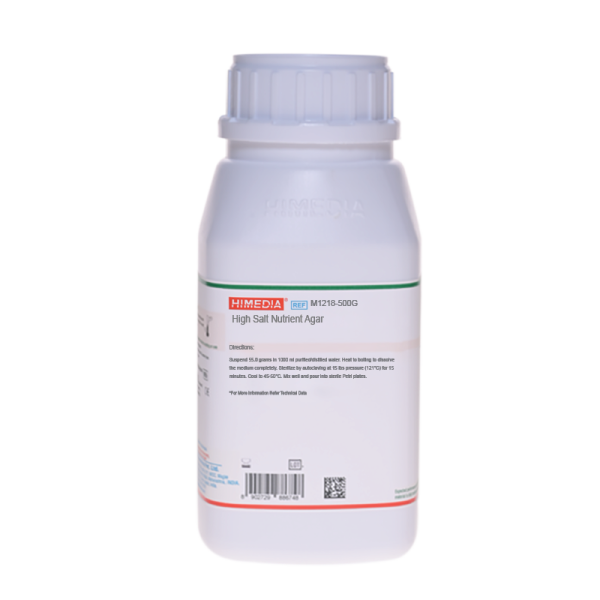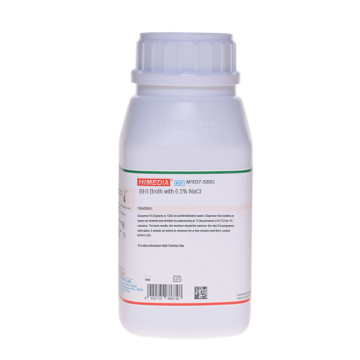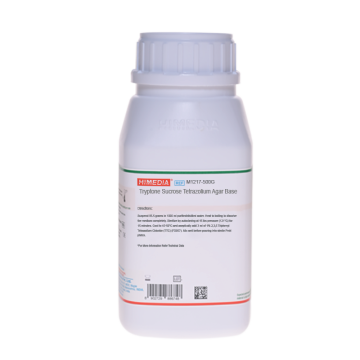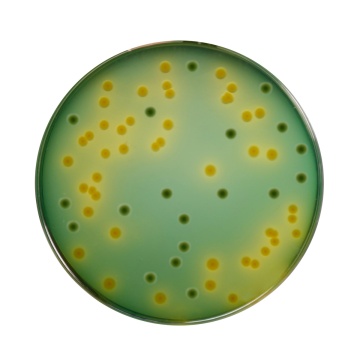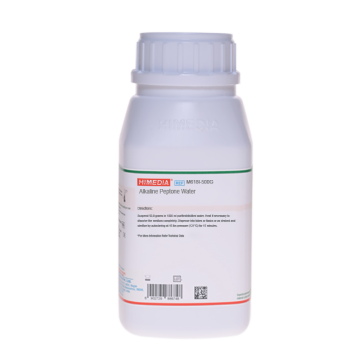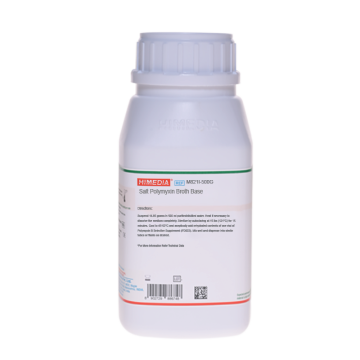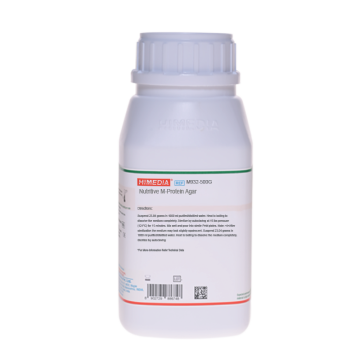 Your enquiry has been submitted
Your enquiry has been submitted
High Salt Nutrient Agar
Identification#CC293D
Intended Use
Recommended for isolation and cultivation of salt tolerant Vibrio species.
Composition**
| Ingredients | Gms / Litre |
|---|---|
| Peptone | 5.000 |
| HM extract # | 5.000 |
| Sodium chloride | 30.000 |
| Agar | 15.000 |
Final pH (at 25°C): 8.5±0.2
**Formula adjusted, standardized to suit performance parameters
# Equivalent to Meat extract
Directions
Suspend 55 grams in 1000 ml purified/distilled water. Heat to boiling to dissolve the medium completely. Sterilize by autoclaving at 15 lbs pressure (121°C) for 15 minutes. Mix well and dispense as desired.
Principle And Interpretation
Vibrios are fairly easy to isolate from both clinical and environmental materials, though some species may require growth factors and /or vitamins. Vibrio parahaemolyticus is the leading cause of bacterial diarrhea associated with the consumption of contaminated food products. Media can be made selective for Vibrios by adding appropriate selective agents (2). High concentrations of NaCl and alkaline pH have also been used to select certain Vibrio species, based on their ability to grow at pH values above 8.0 and at 3% or higher concentrations of NaCl.
Vibrio cholerae is a non-halophilic Vibrio, which cannot grow in media with a concentration of sodium chloride greater than 5-6% and is able to grow in media lacking NaCl (1). High Salt Nutrient Agar is recommended for the isolation, cultivation and confirmation of salt-tolerant Vibrio species in products intended for human consumption or animal feeding stuffs in accordance with ISO Committee under specification ISO/DIS 8914:1990 (3).
HM extract and peptone are sources of carbon, nitrogen, vitamins and minerals. Sodium chloride maintains the osmotic balance of the medium and provides the essential ions.
Type of specimen
Clinical samples: faeces; Food samples
Specimen Collection and Handling
Inoculate 25 grams of test portion to 225 ml Salt Polymyxin Broth Base (M821I) and 225 ml Alkaline Peptone Water (M6181). Incubate the two broths at 35-37°C for 7-8 hours. After incubation, inoculate a loopful from M8211 onto TCBS Agar (M189), Tryptone Sucrose Tetrazolium Agar Base (M1217) and High Salt Nutrient Agar (M1218). Repeat the plating procedure for M618I. Incubate the plates at 35-37°C for 20-24 hours. Confirm presumptive Vibrio colonies by performing the biochemical tests. This can be performed by inoculation into High Salt Peptone Yeast Extract Agar (M1219). This medium can be used to differentiate between aerobic and anaerobic growth.
Warning and Precautions :
In Vitro diagnostic Use. Read the label before opening the container. Wear protective gloves/protective clothing/eye protection/ face protection. Follow good microbiological lab practices while handling specimens and culture. Standard precautions as per established guidelines should be followed while handling clinical specimens. Safety guidelines may be referred in individual safety data sheets
Limitations :
- Further recovery from this enriched broth onto selective media is required.
- Biochemical characterization is carried out from pure isolates for complete identification.
Performance and Evaluation
Performance of the medium is expected when used as per the direction on the label within the expiry period when stored at recommended temperature.
Quality Control
Appearance: Cream to yellow homogeneous free flowing powder
Gelling: Firm, comparable with 1.5% Agar gel
Colour and Clarity of prepared medium: Light yellow coloured, clear to slightly opalescent gel forms in Petri plates
Reaction: Reaction of 5.5% w/v aqueous solution at 25°C. pH: 8.5±0.2
pH: 8.30-8.70
Cultural Response
Cultural characteristics observed after an incubation at 35-37°C for 18-24 hours.
| Organism | Inoculum (CFU) | Growth | Recovery |
|---|---|---|---|
| Vibrio cholerae ATCC 15748 | 50-100 | good-luxuriant | >=50% |
| Vibrio parahaemolyticus ATCC 17802 (00037*) | 50-100 | good-luxuriant | >=50% |
Key: (*) Corresponding WDCM numbers.
Storage and Shelf Life
Store between 10-30°C in a tightly closed container and the prepared medium at 20-30°C. Use before expiry date on the label. On opening, product should be properly stored dry, after tightly capping the bottle inorder to prevent lump formation due to the hygroscopic nature of the product. Improper storage of the product may lead to lump formation. Store in dry ventilated area protected from extremes of temperature and sources of ignition Seal the container tightly after use. Product performance is best if used within stated expiry period.
Disposal
User must ensure safe disposal by autoclaving and/or incineration of used or unusable preparations of this product. Follow established laboratory procedures in disposing of infectious materials and material that comes into contact with clinical sample must be decontaminated and disposed of in accordance with current laboratory techniques (4,5).
Reference
- Bruno Gomez-Gil and Roque A., Isolation, Enumeration and Preservation of the Vibrionaceae, Thompson F. L., Austin B. and Swings J., The Biology of Vibrios, ASM press.
- Collee J. G., Fraser A. G., Marmion B. P., Simmons A., (Eds.), Mackie and McCartney Practical Medical Microbiology, 1996, 14th Edition, Churchill Livingstone.
- International Organization for Standardization (ISO), 1990, Draft ISO/DIS 8914:1990
- Isenberg, (Ed.), 1992, Clinical Microbiology Procedures Handbook, Vol. I, American Society for Microbiology, Washington, D.C.
- Jorgensen, J.H., Pfaller, M.A., Carroll, K.C., Funke, G., Landry, M.L., Richter, S.S and Warnock., D.W. (2015) Manual of Clinical Microbiology, 11th Edition. Vol. 1.
- Salfinger Y., and Tortorello M.L. Fifth (Ed.), 2015, Compendium of Methods for the Microbiological Examination of Foods, 5th Ed., American Public Health Association, Washington, D.C.
Disclaimer :
User must ensure suitability of the product(s) in their application prior to use. Products conform solely to the information contained in this and other related HiMedia™ publications. The information contained in this publication is based on our research and development work and is to the best of our knowledge true and accurate. HiMedia™ Laboratories Pvt Ltd reserves the right to make changes to specifications and information related to the products at any time. Products are not intended for human or animal or therapeutic use but for laboratory, diagnostic, research or further manufacturing use only, unless otherwise specified. Statements contained herein should not be considered as a warranty of any kind, expressed or implied, and no liability is accepted for infringement of any patents.
| Product Name | High Salt Nutrient Agar |
|---|---|
| SKU | M1218 |
| Product Type | Regular |
| Physical Form | Powder |
| Origin | Animal |
| Packaging type | HDPE |
| References | 1.Collee J. G., Fraser A. G., Marmion B. P., Simmons A., (Eds.), Mackie and McCartney Practical Medical Microbiology,1996, 14th Edition, Churchill Livingstone2.Bruno Gomez-Gil and Roque A., Isolation, Enumeration and Preservation of the Vibrionaceae, Thompson F. L., Austin B.and Swings J., The Biology of Vibrios, ASM press.3.International Organization for Standardization (ISO), 1990, Draft ISO/DIS 8914:1990P |
| Customized Product Available | No |



